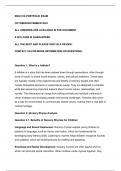ENG1516 PORTFOLIO EXAM
OCTOBER/NOVEMBER 2024
ALL ANSWERS ARE AVAILABLE IN THE DOCUMENT
A 90% PASS IS GUARANTEED
ALL THE BEST AND PLEASE GIVE US A REVIEW.
CONTACT US FOR MORE INFORMATION OR QUESTIONS.
Question 1: What is a folktale?
A folktale is a story that has been passed down through generations, often through
word of mouth, to share moral lessons, values, and cultural traditions. These tales
are typically rooted in the experiences and beliefs of ordinary people and often
include fantastical elements or supernatural events. They are designed to entertain
while also preserving important lessons about human nature, relationships, and
society. The characters can range from talking animals and mythical creatures to
clever tricksters and everyday people overcoming challenges. Folktales also serve
as a way for communities to communicate shared values, making them a vital part of
cultural heritage.
Question 2: Nursery Rhyme Analysis
Question 2.1: Benefits of Nursery Rhymes for Children
Language and Sound Awareness: Nursery rhymes expose young children to
patterns in language, such as rhyme and rhythm, which are fundamental for
developing early literacy skills. Listening to rhymes helps children recognise sounds
and syllables, which are building blocks for reading and speaking.
Emotional and Social Development: Nursery rhymes are often playful and fun,
which can promote social interaction. When children recite rhymes together, they
, practice taking turns, improving their listening skills, and developing a sense of
rhythm and timing, all of which are beneficial for their emotional and social growth.
Question 2.2: Poetic Elements in the Nursery Rhyme
Rhyme: The use of rhyme in the poem where words like “way” and “day” rhyme at
the end of lines creates a sing-song rhythm that’s appealing to children and helps
with memorisation.
Repetition: Phrases such as "Don’t lie, don’t lie little child" are repeated to
emphasise the main message of the poem. This repetition not only reinforces the
moral of the rhyme but also helps young children grasp the concept more easily.
Question 2.3: Do the text and image work well together?
Yes, the text and image complement each other beautifully. The illustration likely
depicts a child with a guilty expression or a parent looking stern, which visually
underscores the poem’s focus on honesty and the consequences of lying. For young
learners, the combination of text and image helps them decode the meaning and
emotions behind the words, making the lesson more memorable. By seeing the
emotions on the characters’ faces, children can better understand the impact of their
actions, reinforcing the poem’s moral message.
Question 3: Folktale Analysis: "How The Tortoise Got The Cracks On His
Shell"
Question 3.1: Which Types of Folktales Does This Story Fit Into?
1. Animal Tales: This story features animals with human characteristics, such
as the Tortoise who speaks and interacts with other animals. Animal tales are
common in African folklore, using animal behaviour to symbolise human traits.
2. Moral Tales: The story clearly conveys a lesson about greed, deception, and
the consequences of selfishness. The Tortoise’s actions—tricking the birds
and eating all the food—lead to a physical punishment (his broken shell),
which serves as a reminder that dishonesty doesn’t go unpunished.




